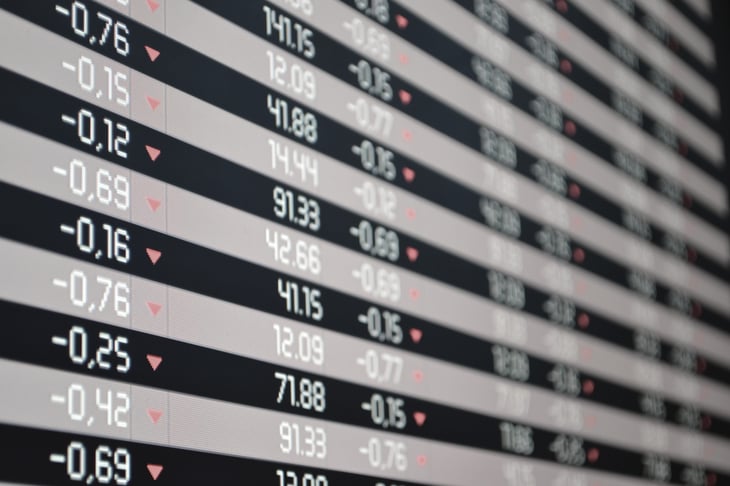

Economic Outlook: Global economy teeters on brink of recession
Economic Research
World faces a challenging year ahead with low GDP growth and stubbornly high inflation
2023 promises to be a challenging year for most markets around the world. Inflation continues to run high, and we now find ourselves in a period of stagflation with low GDP and high price growth. Aggressive action by most central banks seems to have put the brakes on enough for the world to experience what we are calling ‘stagflation light’. This is what the writers of the Atradius Economic Outlook (Senior Economist Theo Smid, Economist Dana Bodnar and myself) consider to be the most likely scenario. However, this is by no means certain. Inflation may become more persistent and could become de-anchored from wages and prices, leading to ‘stagflation strong’ and an even greater slowdown than we are currently predicting for 2023.
For now, the rapidly increasing interest rates combined with high inflation have hit spending power, resulting in a significant slowdown in global demand. However, while 2023 is likely to be a strain for many, there is some light on the horizon as we expect growth to pick up again in 2024 in most markets throughout the world.
In our Economic Outlook, we use a set of assumptions ranging from the most likely scenarios concerning the war in Ukraine, to how supply chains disruptions should abate as the Covid-19 pandemic moves into an endemic phase (among others). Employing these alongside data on developments in global trade during 2022 we calculate the most likely expectations for 2023 in our report, Stagflation light.

Recession looms large
Growth in global GDP is forecast to slump during 2023, dropping sharply from 2.9% in 2022 to just 1.2% in 2023. Although we expect inflation levels to begin to subside over the course of the year, ongoing challenges – particularly the cost-of-living crisis in advanced economies – will result in cutbacks in consumer spending.
Several stagflation forces, including pressures exacerbated by the war in Ukraine and lingering pandemic effects, monetary tightening by central banks and the Chinese slowdown, are already being felt. Industrial production in China, the EU and the US is also set to shrink (as demand lowers). We expect this to become even more marked in 2023, impacting consumer confidence and resulting in a number of countries in negative GDP growth, meaning recession.
What is the economic outlook for advanced economies in 2023?
We are expecting growth to stall in the advanced economies during 2023. After 2022’s rather modest growth of 2.5%, growth is predicted to decline to 0.0% for advanced economies as a whole and to fall into recession for the US, UK and Eurozone.
The impact of the war in Ukraine has been felt most keenly in the Eurozone due to its geographical proximity and heavy reliance on energy imports. Soaring energy costs combined with weakening demand, supply disruptions and input shortages are creating heavy headwinds for the region. In 2024 Eurozone GDP growth is expected to pick up again to 2.1%, as the negative effects of the war wear off.
A mild recession is predicted for the US in early 2023. Consumer demand remained fairly buoyant for the majority of 2022, although we expect to see this slowing down as the effects of rising interest rates (and mortgages) start to be felt in American wallets. This is significant as consumer spending normally accounts for 70% of US economic output.
The UK is predicted to be the worst performing nation of the G7 during 2022, 2023 and possibly beyond. A weak recovery of 1.8% growth is not expected to take hold until 2024, and the UK is unlikely to reach its pre-pandemic GDP level until 2025. During 2023 we forecast a 0.7% contraction in economic output. This is an astonishing 2.0 percentage points lower than we projected in our July Economic Outlook.
We forecast GDP growth in Japan to slow from 1.6% in 2022 to 0.9% in 2023, rebounding to 1.6% in 2024. Although inflation grew quite a bit since the start of the year, from 0.5% in January, to 3.8% in October, it remains much lower than most advanced markets.
What is the economic outlook for emerging economies in 2023?
In general, the future is fairly bright for emerging economies. We expect GDP growth to decelerate to 2.9% in 2023, before rebounding to 4.3% in 2024. We expect Asia will be the fastest growing region in 2023 (3.8%) and that Eastern Europe will avoid a recession in 2023, albeit by a fine margin due to negative growth in Russia and a slowdown in Turkey. Latin America will benefit from improved domestic demand and a better international trade environment.
China’s zero Covid policy had a negative impact on 2022 growth, although we expect a rebound in household consumption during 2023. Inflation has remained fairly stable, helped by a significant level of self-sufficiency in energy and fuel. Real estate investment is likely to stay subdued in China, however, amid weak homebuyer sentiment and defaults among property developers. We forecast growth to rebound to 4.2% in 2023 and to 4.7% in 2024, even though it stays below its pre-crisis trend.
Due to the fallout of the Russia-Ukraine war and a sharp growth slowdown in Turkey, growth in Eastern Europe is coming to a near standstill in 2023 (0.1%), followed by 3.5% growth in 2024. Though the Russian economy is expected to contract in 2023 and 2024, the recession is not as deep as we expected at the start of the conflict. Russia still manages to export large quantities of energy at high prices, despite energy boycotts from Western countries.
Could further energy price shocks impact the outlook?
Further energy price shocks this coming year could have a negative impact on global growth and could lead to an even deeper recession. Additionally, if monetary policymakers fail to rein in price growth and cool the spiral of rising wages to meet the price rises, we are more likely to see ‘stagflation strong’. In this scenario, our predictions for global growth in 2023 would halve from 1.2% to just 0.6%.
We outline our calculations and conclusions in more detail in our report: Atradius Economic Outlook: Stagflation light. This includes an outline of our baseline scenario, ‘stagflation light’ alongside the more negative outlook of ‘stagflation strong.’.
Download the Economic Outlook report here

